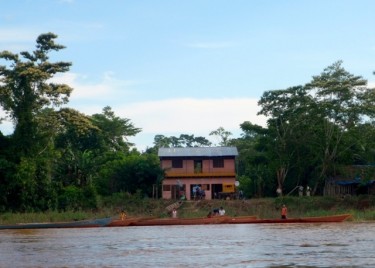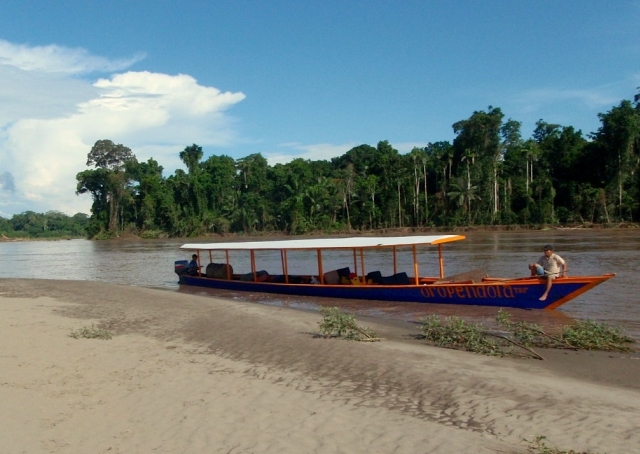This post is part of our special coverage Forest Focus: Amazon [1].
Once again the Inambari Hydroelectric project [2] has leapt to the attention of the Peruvian press, after the recent issuing of two emergency orders that eliminate, for various administrative authorities, [3] [es] the requirement to investigate environmental impact: presumably the Inambari Hydroelectric plant [4] [es] is one of the projects encompassed by these orders.
So what is this project about? According to its official website, Proyecto Inambari [5], it has to do with a large hydroelectric plant to be built in the river Inambari [6], whose length spans the Amazonian regions of Puno [7], Cuzco [8] and Madre de Dios [9]. It is forecast to be the fifth biggest dam in the region, with a total installed capacity of 2,200 Megawatts, with its construction requiring an investment of US $4 billion.
From the very beginning the project has generated opposition amongst locals, firstly due to the imminent ecological impact and because 101 kilometres of the Interoceana Sur highway [11][es] will be covered by the reservoir, and secondly because it clearly implies a displacement and relocation of some 60 populated centres [12] [es] of Puno, Madre de Dios and Cuzco, in many cases against the wishes of their inhabitants, who do not wish to find themselves obligated to leave their towns. However, local authorities have expressed their support [13] [es] for the Inambari project.
Congressman Johnny Lescano stresses the impact that this plant will have on the ecosystem: according to reports produced by Egasur [14] [es], the project’s developer, the dam will a) cause disturbances in the biological cycles of aquatic flora and fauna, b) mean loss of woodland, death of animals and even extinction of local species, c) increase the risk of illnesses such as malaria, yellow fever, dengue fever, etc d) generate global warming toxic gases, produced by the decomposition of the drowned flora, which will release more than 69 million tonnes of CO2.
Pablo Raúl Fernández, in Sociología Política [15] [es], points out alleged legal inconsistencies in the recent orders that would give the green light to the project
Nadie entiende cómo una norma con rango de ley, que el Poder Ejecutivo sólo puede dar en caso de urgencia económica y financiera, termine abordando temas ambientales y lo que es peor, eliminando requisitos fijados para obtener una concesión en esta materia. Por ello muchas instituciones, como el Instituto de Defensa Legal, están reclamando la inconstitucionalidad de esos decretos. Asimismo, esta semana se han pronunciado diversas organizaciones que siguen con preocupación el caso de las grandes hidroeléctricas que incluyen represas en la selva peruana…
Ewing Jesús Falla, in the blog Nauseapolítica [16] [es] appeals to the presidential candidates to address the matter [16] [es]:
Lejos de defender nuestra Amazonía, se la viene subastando para beneficiar a Estados vecinos… La cuestión ahora es saber si los candidatos a la Presidencia en el Perú, van a priorizar temas como este o si sólo van a bendecir las atrocidades y corruptelas que deja el gobierno aprista liderado por quien ha resultado ser el mejor vendedor de nuestros recursos: el señor Alan García Perez. El tema esta en la mesa, los ciudadanos peruanos esperamos sus respuesta señores candidatos !!
However, it is also necessary to consider what J. Francisco Canaza points out in his blog Apuntes Peruanos [19] [es]:
Hace más de cinco años señalamos que Brasil iba a requerir más energía a cargo de sus ratios de desarrollo. Y que, o la obtenía de Bolivia o de nosotros. (…) La situación nos ha puesto en el casi deber de ser proveedores. Ante esta circunstancia, lo necesario es establecer el cómo cumplir con esas necesidades sin destruir nuestros recursos, tanto energéticos como naturales. Se necesita establecer un modelo en el que se desarrolle socialmente la zona sur del país sin perjudicar el entorno natural.
Meanwhile, President Alan García has let slip that it is possible that the orders will be “reevaluated by the cabinet [21]”[es]; congressman Johnny Lescano has announced that he will present a claim of unconstitutionality against these emergency orders; and the Vice President of Energy, Daniel Cámac, has released a statement to the press emphasising that the Inambari project will not be carried out until the Amazonian Electric Generation Company manages to obtain a social licence [22] [es].
The debate has extended as far as Twitter. Former Congressaman Javier Diez Canseco (@javierdcc [23]) comments:
@javierdcc [23] Inambari: poderosos intereses en juego, grandes constructoras d Brasil d dudosa reputación por irregilaridades,y un fuerte impacto ambiental
While user Aber Ver-Val (@catadioptrico [25]) replies:
@catadioptrico [25] @javierdcc [26] asi como estas en contra de inambari,xq no dices nada de todo el microtrafico de madera hecha por peruanos en las narices d todos.
Diego (@lokerias [28]) demands that the matter enters into the electoral campaign;
A Garcia le convienen los enfretamiento entre los candidato, asi, no nos preocupamos por Inambari , atención ¡¡ investiguen ¡¡
Emma Robles (@RosaEmma89 [29]) calls upon candidate Alejandro Toledo to take a position on the matter:
@RosaEmma89 [29] @atoledomanrique [30] , tómese la molestia de responder al electorado si está o no a favor de la construcción de la hidroeléctrica inambari.
MonicaSol (@monicasol_35 [32]) asks about the environmental impact:
@monicasol_35 [32]@carlos1cd [33] la mineria informal en MDD [la región Madre de Dios] lleva casi 40 años, encima se viene la represa de Inambari y los pozos petrolíferos caletas [“escondido” en jerga peruana] de HuntOil.
Ana Karina (@Apioverde) [35] asks about the 101 km of highway that will be left under water.
¿No que la carretera será inundada por la hidroelectrica de Iñambari? Pregunto nomás.
The issue of the destination for the energy is dealt with by Rosario Linares:
@maroliva22 [36] La energía de la CH Inambari, no será del Perú sino de los brasileros, pero Alan tenía que aceptar la orden de Brasil.
Meanwhile, opposition to the emergency orders has looked beyond these regions and is organizing protests in Lima, the Peruvian capital, demanding that they are revoked [38] [es]; and additionally claiming that, according to Mariano Castro, of the Peruvian Society of Environmental Law, these orders breach the right to previous consultation [3] [es].
The project has also generated rejection at a political level, and in public opinion, given that the majority of the energy produced will be destined for Brazil, not Peru. Regarding this, J. Francisco Canaza points out in his blog [19] [es] that it is necessary to promote a use of resources in a way that promotes development within the region, not only in Brazil.
Peruvians look forward to hearing news regarding this project and its extent over the coming weeks.
This post is part of our special coverage Forest Focus: Amazon [1].


